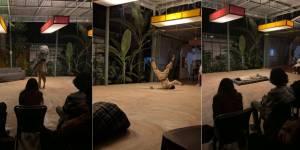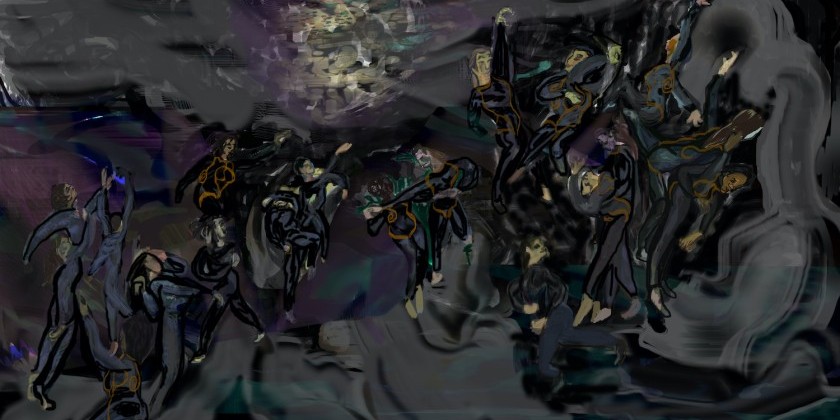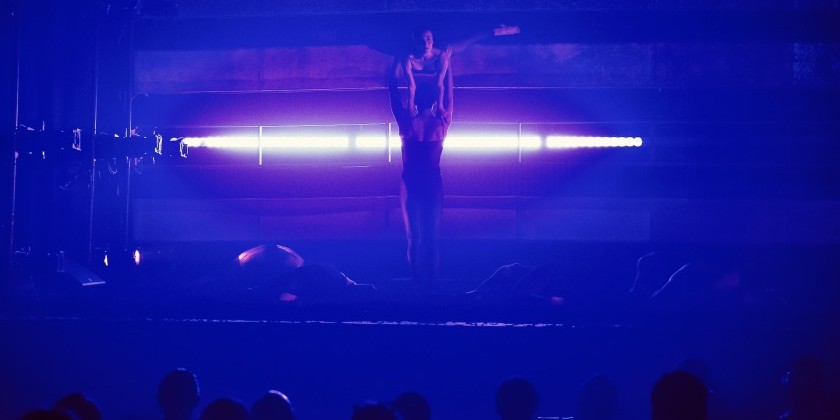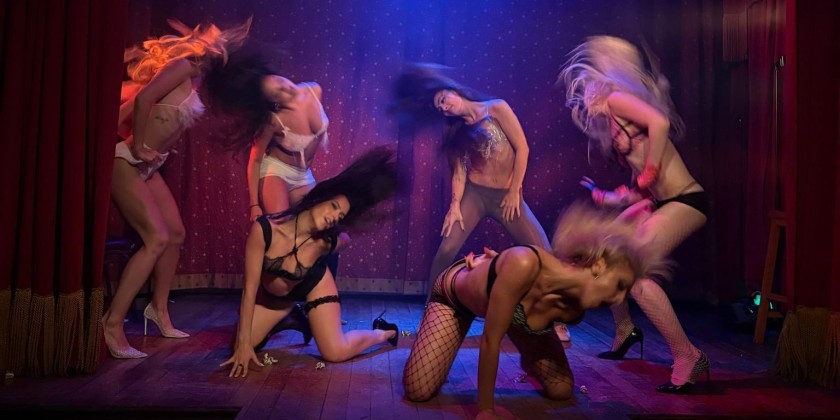AUDIENCE REVIEW: An Evening with Sikora + Dance and Summation Dance
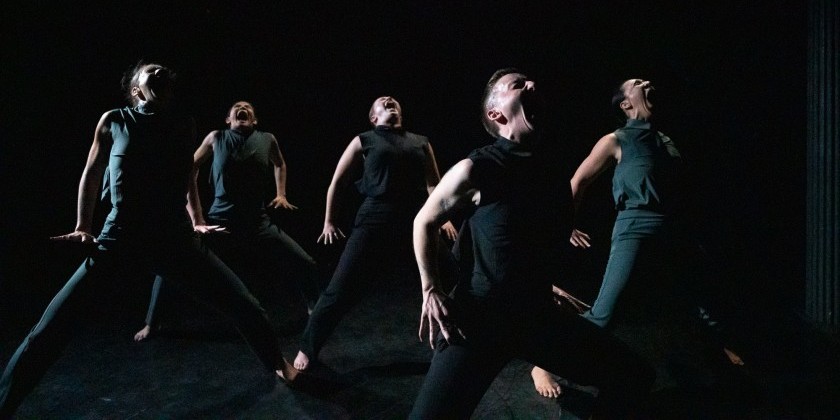
Company:
Sikora + Dance | Summation Dance Company
Performance Date:
March 23-25, 2023
Freeform Review:
Summation Dance Company is a New York City and Los Angeles based contemporary dance troupe, founded in 2010 by Sumi Clements and Taryn Vander Hoop, both Dance MFA graduates of NYU's Tisch School of the Arts. Sikora + Dance is a new company founded by Caitlin Sikora, also an MFA Dance graduate of NYU Tisch and a practicing software engineer.
The March performance, a split bill produced as part of Gibney Dance's Performance Opportunities Project at Gibney Agnes Varis Performing Arts Center in New York, New York, marked the new company’s debut alongside veteran troupe Summation.
Three Neapolitan Songs
Choreography by Caitlin Sikora in collaboration with Joseph Giordano and the dancers
In this narrative duet set to music by Neapolitan singer-songwriter Roberto Murolo, dancers Xenia Mansour and Jared McAboy wore pedestrian attire in complementary blues and burnt orange hues. In “Casa Sulitaria (Lonely House),” the partners' floorwork and spirals were often synchronized but rarely brought them into contact with one another. These choreographed missed connections corresponded to the tone of longing set by the accompaniment. In “Giuramento (Oath)”, the dancers’ movements became more variable with each dancer furtively accepting assistance for turns and glides until the song ended with their hands entwined. While the duet was packed with partnering work, it eschewed the norms of pas de deux, placing ambivalence at the heart of this unconventional love story. The last piece, “Resta Cu Me (Stay Here with Me)” delighted with the physicality of its jumps and lifts. Mansour and McAboy were now collaborating for partnered phrases but also taking turns in independent moments of virtuosity. I interpreted the piece as a commentary on the challenges of communicating in a maturing romantic relationship. There can be sharing without intimacy or true intimacy which makes space for the “I” and the “we”. Overall, Sikora’s choreography successfully highlighted each dancers’ skill without sacrificing storytelling—a feat in this age of short attention spans.
Lux Perpetua (Preview)
Choreography by Caitlin Sikora in collaboration with the dancers
With eight dancers including Sikora costumed in light gray knee-length dresses with matching gauze shawls, the piece was set to two versions of “Requiem Aeternam,” the first movement of the Catholic funeral mass. The first was an electronic chant composed by Caitlin Sikora and Jon Tippens with Latin vocals provided by the dancers; the second was the bold, familiar Verdi composition. The dancers, who ranged in height and body type, began in a tight, staggered formation alternating between upright and prostrate positions. Because their arm movements were out of sync with their hip undulations, the section felt like a commentary on the discomforts of conformity.
In the second part, which was choreographed to the slow opening movement of Verdi’s Messa da Requiem, the dancers paired off. In keeping with the mournful music, each dancer approached and retreated from her partner, as if desiring, but failing to embrace. The section ended with the powerful imagery of seven of the dancers lifting the eighth, India Hobbs, and carrying her with the solemnity of pallbearers. In the last section, the tempo increased in the Kyrie portion of the Requiem, and the previously cool stage lighting warmed. The dancers’ movements were no longer synchronous. Instead, they appeared free, rapturous, and expansive. Twice, the dancers arranged themselves by height facing downstage, so that from the audience they appeared as a single figure. When each dancer peeled away from the line, her arms flapped. As the piece closed, the dancers reassembled themselves on the diagonal toward downstage. I was reminded of gulls, who align themselves to face the wind for stability, but also to make flight possible. Perhaps it was the dirge-like start and the hopeful finish, but I felt a strong emotional arc and resolution watching the piece. I appreciate that Sikora employed a large ensemble and took risks with challenging choreography–especially during the first section when the dancers' asynchronous limb movements made each appear disembodied. I look forward to seeing this substantial work again when no longer in previews.
Episodes and Entanglements (Excerpt)
Choreography by Taryn Vander Hoop with contributions from the dancers, Tippy Dringman, Annalise Gehling, and Rosalynde LeBlanc
This trio attired in denim coveralls wowed with technical acumen. LeBlanc started as a soloist from a seated position, where she rocked in time to the stirring instrumentals of “Won’t be a Thing to Become” by Colin Steston and Sarah Neufield. The image of Leblanc- head cradled in hands, then fingers running, then frantically pulling hair--captured the essence of early pandemic life. The score transitioned to “Ideas/ideas/ideas!!!” by Malcolm Tulip, a spoken-word piece. LeBlanc moved to an upright position and her footprint on the stage expanded but remained confined to an invisible boundary. Laughter reverberated through the audience when the score became a mantra, “I need to stop scrolling”. A slapstick frenzy followed as the soloist walk-ran about the stage; she made facial grimaces and exaggerated movements with astounding precision. The section ended when she gave birth to a grapefruit. I couldn’t help but think of Rosie the Riveter—how women aspired to independence through work, and now that often means laboring alone.
Then Dringman and Gehling emerged, dancing to a futuristic, electronic beat which felt jarring in contrast to the cotton denim they were wearing. Their movements appeared evolutionarily or programmatically conditioned. Both dancers glided on hands and knees like primates, then thumbed their noses at one another in childlike derision. Eventually, their postures returned to hominid, and they darted about, mirroring one another with movement sequences and a rhythmic accuracy that recalled Cunningham. LeBlanc re-appeared and the other two dancers relaxed into more playful forms. The piece ended when the soloist rolled tangerines scatter shot from upstage and stage lights faded to black. I am still unsure how to interpret the juxtaposition of a soloist engaged in tormented inner dialogue and a dyad consumed with its other half. Like a Beckett play, this ambiguity in no way diminishes the satisfaction I experienced watching the performance and the pleasure of contemplating it now. Use of citrus props could have ended in disaster, but not in Vander Hoop’s dexterous hands.
Futile Ground
Choreography by Sumi Clements with contributions from the dancers
The last work of the evening featured five dancers, including Clements; all wore monochrome slacks and sleeveless shirts fully buttoned-- three dancers in olive and two in black. During the first section, which was set to “132”, an ambient piece by the Russian sound artist CoH, the stage was bathed in a bluish light. In flawless unison, the quintet started upright with sharp, stiff gestures. Their regimented movements and camouflage colors made me think of a military exercise. At one point, much of the movement was concentrated upstage, where, backs to the audience, the dancers lunged side to side and boxed the air. They then assembled in a tight circular formation and moved mechanically. Intermittently, one of the dancers would perform an individual phrase in a burst of sinuous forms. The next moment she was back, however, towing the line; this monotonous movement persisted until the score faded to silence.
The tone of the work changed with the piano melody, “Para Ti” by Andreas Wolff. Initially, four dancers stood at corners of an invisible square with one dancer at its center until two dancers, Elizabeth Dashiell and Emily Tellier, dressed in black entered a physical dialogue composed of more spontaneous movements and weightless lifts. Then the stage lights dimmed, and the music grew unnervingly loud, when two of the dancers, Clements and Devin Oshiro, in olive ran up the aisles and re-appeared at the top of the stairs under yellow spotlights. They seemed to mirror one another’s movements; however, the audience, which was positioned between the aisles, could not watch both dancers simultaneously. As we looked from side to side, we lost sight of half of the pair. Eventually the quintet reassembled at center stage. Each dancer moved independently in relatively languid fashion, until they reconstituted into a pentagon and resumed the matching automatic movements of the piece’s start. They continued to dance in this manner until after the stage lights dimmed to black. Overall, Clements’ choreography successfully captured a sense of futility as the adept dancers became facsimiles of themselves and danced past exhaustion. As I watched, my mind wandered to the violence of capitalism, especially digital capitalism, as well as the war in Ukraine. Writing this review later, I’m still pondering the work's meaning, which to me, feels like an encore.
Perhaps it was something about showing up in person to experience live dance on the third anniversary of COVID-19’s arrival to New York City in March 2020, but this joint program by Summation Dance and Sikora + Dance felt significant for me and for others I spoke to in the audience afterward. Though the pieces were distinct, the masterful movements throughout the program reminded me we are miraculously embodied. Now is contemporary dance’s moment to reconnect with audiences old and new who are craving its varied forms.
Author:
Catherine Parker
Photo Credit:
John Suhar




